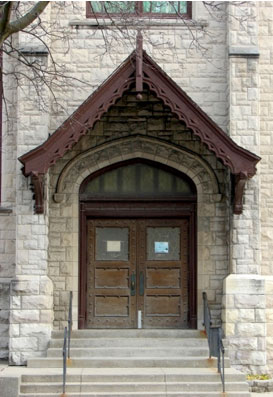43. Evangelical Lutheran Church of the Epiphany, 1905
Now All Peoples Lutheran Church
2600 North 2nd Street (at Clarke Street)
Architect: John Roth, Jr.
Organized in 1903 and incorporated in 1905, Epiphany Lutheran was one of several English-language Lutheran churches established in Milwaukee between the beginning of the last century and World War I. During the nineteenth century, nearly all of the city’s Lutheran churches conducted services in German or one of the Scandinavian languages. Although the neighborhood’s residents were primarily of German ancestry at the time of Epiphany Lutheran’s founding, and German was still widely spoken in Milwaukee, the church attracted English-speaking members from among the many adult children and grandchildren of German immigrants.
Construction of the church began in 1905, with the first services held in the basement of the unfinished building in December of 1906. The church was completed in the spring of 1907. The high foundation walls are of locally quarried limestone from Milwaukee County or adjacent Waukesha County, while the upper walls and tower are of Bedford limestone from quarries in southern Indiana. As at Summerfield Methodist, the church has a castellated bell tower with no steeple.
Epiphany is one of the earliest churches in Milwaukee to incorporate the Tudor arch in its doorways and windows. In a typical Gothic arch, each of the two curved sides is of uniform radius. In contrast, a Tudor arch springs from the side walls with curves of relatively small radius, then extends to the central point with curves of much larger radius. The result is a pointed arch with a broad and flattened appearance, lacking the height of a traditional Gothic pointed arch. The Tudor arch was first used in late English Gothic architecture of the fifteenth and sixteenth centuries. Among Gothic Revival churches, this type of arch is most often seen in the second and third decades of the twentieth century, with several examples in Milwaukee dating to the 1920s.
The building’s architect, John Roth, Jr. (1866-1944) was born in Cedarburg, Wisconsin and had an office in Milwaukee from the mid-1890s through the 1920s. Most of his work was residential, but he designed two other churches in Milwaukee: St. John’s Methodist at 3rd Street and Concordia Avenue (built in 1899) and Reformation Lutheran at 35th Street and Garfield Avenue (built in 1908). Reformation Lutheran is quite similar in its design and materials to the smaller Epiphany Lutheran.
In its current form, Epiphany Lutheran is substantially larger than the building designed by Roth and completed in 1907. It was enlarged in the mid-1920s based on a design by Milwaukee architect Hugo Haeuser, who at that time was in the early stages of a long career as a church specialist. In preparation for the building’s enlargement, the church acquired the adjacent lot to the east and demolished an existing residence there. The building was then extended 51 feet to the east, enlarging the worship space and adding the present chancel, as well as providing new Sunday school classrooms in the wing to the north. Haeuser’s addition is seamless, matching the forms, proportions, and materials of the original building. For example, the large window on the right side of the Clarke Street façade, which was part of the addition, matches the original window to the left in its size, shape, and tracery. The new windows have stained glass that is similar to the originals in style and color.
The church was reconstituted in the early 1990s as All Peoples Gathering, also known as All Peoples Church. The change was in response to the increasing diversity of both the neighborhood and the congregation itself. Today, the church places a strong emphasis on community engagement, with its food pantry, urban gardening projects, and youth programs.
Sources:
“Faith Through 70 Years,” pamphlet by the Lutheran Church of the Epiphany, 1975.
Haeuser, Hugo, architect. Drawings for addition to Epiphany Lutheran Church, dated June 4, 1925. Wisconsin Architectural Archive, Milwaukee Central Library, drawing set 65-64.
Historic Designation Study Report: Epiphany Lutheran Church. City of Milwaukee, Department of City Development, n.d.

